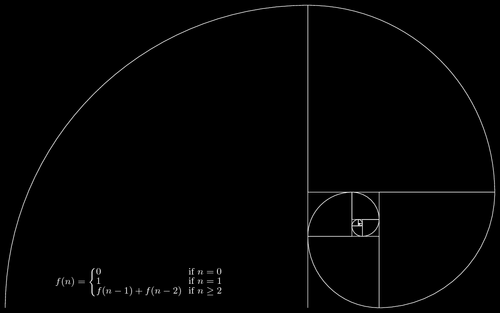
Edit and compile if you like:
% Fibonacci spiral
% Author: Andrew Mertz
\documentclass{minimal}
\usepackage{amsmath,tikz}
\usetikzlibrary{backgrounds,calc}
\usepackage[active,tightpage]{preview}
\PreviewEnvironment{tikzpicture}
\setlength\PreviewBorder{0pt}%
\begin{document}
% I have seen many beautiful depictions of Fibonacci spirals and
% golden spirals. So I thought it would be nice to make a Fibonacci
% spiral in TikZ. I like the look of white on black so here I define a
% black background rectangle.
\begin{tikzpicture}[background rectangle/.style={fill=black},
show background rectangle]
% Create some counters for holding the Fibonacci numbers
\newcounter{a}
\newcounter{b}
\newcounter{temp}
% Initialize the counters
\setcounter{a}{0}
\setcounter{b}{1}
% The spiral will start at the origin
\coordinate (0) at (0,0);
% This loop defines the number of turns in the spiral. Note that we
% will have to be careful not to overflow our counters or make the
% spiral too large for TeX to handle. This is easy to do as the
% Fibonacci sequence grows exponentially.
\foreach \i in {1,...,18}
{
% Get the "name" of the last point on the spiral
\pgfmathsetmacro{\lastpoint}{\i-1}
% Compute the angle for this turn of the spiral
\pgfmathsetmacro{\startangle}{mod(\i-1,4) * 90}
% Draw this turn of the spiral and remember the point where we end
\draw[white] (\lastpoint) arc
(\startangle : \startangle + 90 : \value{b}/10.0pt) coordinate (\i);
% Compute the next Fibonacci number
\setcounter{temp}{\value{b}}
\addtocounter{b}{\value{a}}
\setcounter{a}{\value{temp}}
}
% Add some framing for the spiral while at the same time not "boxing"
% it in. Note that to put a square around each turn of the spiral we
% could have just used the command \draw[white] (\lastpoint)
% rectangle (\i); after drawing each turn in the loop above.
\foreach \i in {1,3,...,17}
{
\pgfmathsetmacro{\lastpoint}{\i-1}
\draw[white] (\lastpoint) -| (\i);
}
\foreach \i in {2,4,...,16}
{
\pgfmathsetmacro{\lastpoint}{\i-1}
\draw[white] (\lastpoint) |- (\i);
}
\draw[white] (17) -- (17 |- 18);
% Add some text displaying the formula for the Fibonacci numbers
\node(eq) at ($(18) + (2.5,1)$)
[white,text width = 2cm,font=\fontsize{8}{8}\selectfont] {
\begin{displaymath}
f(n) = \left\{
\begin{array}{lr}
0 & \text{~~if } n = 0\\
1 & \text{~~if } n = 1\\
f(n-1) + f(n-2) & \text{~~if } n \geq 2\\
\end{array}
\right.
\end{displaymath}
};
\end{tikzpicture}
\end{document}
% LocalWords: tikzpicture eq lr TikZClick to download: fibonacci-spiral.tex • fibonacci-spiral.pdf
Open in Overleaf: fibonacci-spiral.tex


